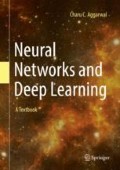Abstract
Radial basis function (RBF) networks represent a fundamentally different architecture from what we have seen in the previous chapters. All the previous chapters use a feed-forward network in which the inputs are transmitted forward from layer to layer in a similar fashion in order to create the final outputs.
“Two birds disputed about a kernel, when a third swooped down and carried it off.”—African Proverb
Access this chapter
Tax calculation will be finalised at checkout
Purchases are for personal use only
Bibliography
C. Aggarwal. Machine learning for text. Springer, 2018.
C. M. Bishop. Neural networks for pattern recognition. Oxford University Press, 1995.
C. M Bishop. Improving the generalization properties of radial basis function neural networks. Neural Computation, 3(4), pp. 579–588, 1991.
D. Broomhead and D. Lowe. Multivariable functional interpolation and adaptive networks. Complex Systems, 2, pp. 321–355, 1988.
M. Buhmann. Radial Basis Functions: Theory and implementations. Cambridge University Press, 2003.
S. Chen, C. Cowan, and P. Grant. Orthogonal least-squares learning algorithm for radial basis function networks. IEEE Transactions on Neural Networks, 2(2), pp. 302–309, 1991.
T. Cover. Geometrical and statistical properties of systems of linear inequalities with applications to pattern recognition. IEEE Transactions on Electronic Computers, pp. 326–334, 1965.
B. Fritzke. Fast learning with incremental RBF networks. Neural Processing Letters, 1(1), pp. 2–5, 1994.
E. Hartman, J. Keeler, and J. Kowalski. Layered neural networks with Gaussian hidden units as universal approximations. Neural Computation, 2(2), pp. 210–215, 1990.
S. Haykin. Neural networks and learning machines. Pearson, 2008.
M. Kubat. Decision trees can initialize radial-basis function networks. IEEE Transactions on Neural Networks, 9(5), pp. 813–821, 1998.
C. Micchelli. Interpolation of scattered data: distance matrices and conditionally positive definite functions. Constructive Approximations, 2, pp. 11–22, 1986.
J. Moody and C. Darken. Fast learning in networks of locally-tuned processing units. Neural Computation, 1(2), pp. 281–294, 1989.
M. Musavi, W. Ahmed, K. Chan, K. Faris, and D. Hummels. On the training of radial basis function classifiers. Neural Networks, 5(4), pp. 595–603, 1992.
M. J. L. Orr. Introduction to radial basis function networks, University of Edinburgh Technical Report, Centre of Cognitive Science, 1996. ftp://ftp.cogsci.ed.ac.uk/pub/mjo/intro.ps.Z
J. Park and I. Sandberg. Universal approximation using radial-basis-function networks. Neural Computation, 3(1), pp. 246–257, 1991.
J. Park and I. Sandberg. Approximation and radial-basis-function networks. Neural Computation, 5(2), pp. 305–316, 1993.
H. Sarimveis, A. Alexandridis, and G. Bafas. A fast training algorithm for RBF networks based on subtractive clustering. Neurocomputing, 51, pp. 501–505, 2003.
B. Schölkopf, K. Sung, C. Burges, F. Girosi, P. Niyogi, T. Poggio, and V. Vapnik. Comparing support vector machines with Gaussian kernels to radial basis function classifiers. IEEE Transactions on Signal Processing, 45(11), pp. 2758–2765, 1997.
D. Wettschereck and T. Dietterich. Improving the performance of radial basis function networks by learning center locations. NIPS Conference, pp. 1133–1140, 1992.
Author information
Authors and Affiliations
Rights and permissions
Copyright information
© 2018 Springer International Publishing AG, part of Springer Nature
About this chapter
Cite this chapter
Aggarwal, C.C. (2018). Radial Basis Function Networks. In: Neural Networks and Deep Learning. Springer, Cham. https://doi.org/10.1007/978-3-319-94463-0_5
Download citation
DOI: https://doi.org/10.1007/978-3-319-94463-0_5
Published:
Publisher Name: Springer, Cham
Print ISBN: 978-3-319-94462-3
Online ISBN: 978-3-319-94463-0
eBook Packages: Computer ScienceComputer Science (R0)

